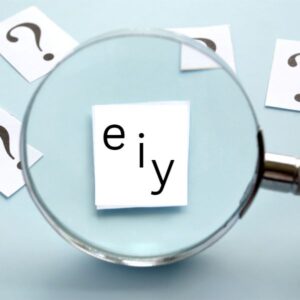A Few Reliable Spelling Patterns
Are there reliable spelling patterns? Often we hear that English spelling is crazy. It’s not. There are many reliable spelling patterns. What makes a spelling pattern reliable? It wouldn’t have many exceptions. Here are a few to start with.
Final <ff>, <ll>, <ss>, <zz>
Why are there two <f>s at the end of staff but only one <f> at the end of shelf ? How about the <l>s in still and feel, the final <s>es in glass and bus, or the <z>s at the end of buzz and waltz?
Sometimes called the FLOSS rule or Z-FLOSS, it describes when to spell with a final <ff>, <ll>, <ss>, or <zz>. Double a final <f>, <l>, <s>, or <z> when it immediately follows a single vowel letter. For example, staff has a single vowel letter so we double the <f>.

In shelf, there’s an <l> between the vowel grapheme and the final <f>. It’s not immediately following the vowel.
What about feel? It has two vowel letters, a vowel digraph. There isn’t a single vowel letter.
Following the pattern, you’d expect bus, yes, was, is, etc. to end with <ss>. Bus is a clip of an older word, omnibus, like gas and gasoline. Yes arrived in English coming from an Old English phrase, with the sense of “yea it is.” Was, is, has, and as are function words. They serve a function in sentences without bringing “meaning” as content words do. Clips, compressed phrases, and function words don’t typically follow our accepted English spelling patterns. Neither do words from other languages.
Waltz has two consonants, <l> and <t>, between the vowel and the final <z>. Quiz may be a combination of words from Latin qui es or it may be an exception to the pattern. Look up whiz in Etymonline. Why might it not follow the pattern?
Examples:
- off, cuff, stiff, staff, whiff
- all, fell, doll, chill, fluff
- mass, mess, miss, moss, floss
- buzz, fizz, jazz, frizz, pizzazz
It’s a challenge for students to memorize spellings or to just see it and remember the spelling. It’s difficult to retain spelling rules which apply to a specific set of letters with a specific position and circumstances.
Yes, it’s a reliable spelling pattern, but they need practice. And the practice can’t be boring drill. They do better with engaging activities. Letting them create crazy sentences with the words is one activity. Spelling games of chance are also effective. Practicing with word families provides more practice.
Initial <c> or <k>
New students often ask if they should spell a word with a <c> or a <k>. That’s when they begin learning how to make that choice. For most words, we notice if there would be an <e>, <i>, or <y> right after the initial /k/ phoneme.
If there’s an <e>, <i>, or <y> immediately following the /k/, we will use a <k>. Students review those three vowel letter names in connection with this pattern. Again, this requires them to notice the graphemes in a word and to think and remember what they’ve been taught. For most students, it takes repeated practice and time.

Examples
- cast
- cobble
- customer
- clip
- cry
- kelp
- kiss
- Kyle
Notice that in clip and cry there is an <i> and a <y> following the <c> but those letters aren’t right after the <c>. There’s another letter between them, a consonant <l> or <r>. The <c> spells /k/ in those words.
Are there exceptions to this rule? Over time I realized there were some words that don’t fit the pattern. Kale, skunk, kabob, kook, kaput, karma, kazoo, kudos, karate, karaoke, kayak, kumquat, kosher, kowtow, kangaroo, koala, kamikaze, kaleidoscope, and kookaburra are some of them. Some came to English from the languages of indigenous people in North America or Australia. Others came from other Asian or European languages. A few just didn’t get the memo.
So by my definition, is this spelling pattern reliable? 20 exceptions are more than a few, right? Yeah. But most of these aren’t native English words. Their spelling came to us Anglophones with different spelling conventions. I’m calling the pattern reliable in native English words.
But why can’t we use a <c> to spell /k/ before <e>, <i>, or <y>?
<c> followed by <e>, <i>, or <y>
<C> when followed by <e>, <i>, or <y> spells /s/. This is extremely reliable. I thought it was 100% reliable. Then I stumbled upon one exception when we had an electrical problem in our home. The electrician said there were wires that weren’t installed properly and they were “arcing“. That’s why we sometimes smelled a burning smell in this room. Yikes!

I pulled out my phone and started texting my husband. Dumbstruck, I stopped at the word arcing. Wait a minute, that can’t be right… I tried <arcking> but really questioned myself on that. I looked it up in an online dictionary. It’s spelled <arcing>, but pronounced /ɑrk iŋ/. An exception to my favorite spelling sure-thing.
So, “most of the time,” “99% of the time”, <c> when followed by <e>, <i>, or <y> spells /s/. This is true regardless of the position within a word. It’s also why we sometimes do not replace a final <e> before a vowel suffix. If the base ends with <ce> and the suffix doesn’t start with <e>, <i>, or <y>, then we leave the final <e> of the base to indicate the pronunciation of the <c> as /s/.
Examples:
- cent
- city
- cycle
- fencing
- traceable
Students easily get the hang of dropping, or replacing a final <e> before a vowel suffix. But they will need plenty of practice with keeping an <e> instead of dropping it. Again, lots of noticing and thinking.
For reading, students often forget <c> will be pronounced /s/. We use phrases and sentences in reading fluency games for more exposure. All the games we play are games of chance so that the student and the tutor have equal opportunity to win. It’s the luck of the draw, which means it’s fun for both of us.
These are just a few of the reliable spelling patterns in English. Sharing these with students gives them confidence in themselves and the spelling system. They are some of their tools.

